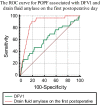Drainage volume on postoperative day one to predict clinically relevant postoperative pancreatic fistula following distal pancreatectomy
- PMID: 35909183
- PMCID: PMC9341036
- DOI: 10.1186/s12893-022-01748-z
Drainage volume on postoperative day one to predict clinically relevant postoperative pancreatic fistula following distal pancreatectomy
Abstract
Background: The purpose of this study was to determine how the drain fluid volume on the first day after surgery (DFV 1) can be used to predict clinically relevant post-operative pancreatic fistula following distal pancreatectomy (DP).
Method: A retrospective analysis of 175 patients who underwent distal pancreatectomy in hepatobiliary surgery at Chengdu 363 Hospital (China) from January 2015 to January 2021 has been performed. Depending on the presence of pancreatic fistula, all patients were divided into two groups: POPF and non-POPF. The clinical factors were analyzed using SPSS 17.0 and Medcalc software. In order to assess the effectiveness of DFV 1 in predicting POPF after surgery, ROC curves were used to calculate its cut-off point,, which yielded sensitivity and negative predictive value of 100% for excluding POPF.
Result: Of the 175 patients who underwent distal pancreatectomy, the incidence of overall pancreatic fistula was 36%, but the rate of clinically significant (grade B and C) fistula, as defined by the International Study Group on Pancreatic Fistula, 30 was only 17.1% (28 grade B and 2 grade C fistula). The results from univariate and multivariate logistic regression analysis showed that drain fluid volume on the first postoperative day (OR = 0.95, P = 0.03), drainage fluid amylase level on POD1 (OR = 0.99, P = 0.01) and the preoperative ALT level (OR = 0.73, P = 0.02) were independent risk factors associated with CR-POPF. Receiver operating characteristic (ROC) curve analysis revealed that a drainage volume of 156 mL within 24 h and an amylase greater than 3219.2 U/L on the first postoperative day were the optimal thresholds associated with complications.
Conclusion: After distal pancreatectomy, the drainage volume on the first postoperative day can predict the presence of a clinically relevant pancreatic fistula.
Keywords: Distal pancreatectomy; Postoperative pancreatic fistula; The drainage volume on the first postoperative day.
© 2022. The Author(s).
Conflict of interest statement
The author(s) declare that they have no competing interests.
Figures
Similar articles
-
Drain fluid and serum amylase concentration ratio is the most reliable indicator for predicting postoperative pancreatic fistula after distal pancreatectomy.BMC Surg. 2023 Apr 12;23(1):87. doi: 10.1186/s12893-023-01980-1. BMC Surg. 2023. PMID: 37046241 Free PMC article.
-
Validation of day 1 drain fluid amylase level for prediction of clinically relevant fistula after distal pancreatectomy using the NSQIP database.Surgery. 2019 Feb;165(2):315-322. doi: 10.1016/j.surg.2018.07.030. Epub 2018 Nov 7. Surgery. 2019. PMID: 30414706
-
Optimal cutoff values of drain amylase for predicting pancreatic fistula are different between open and laparoscopic distal pancreatectomy.Surg Endosc. 2024 May;38(5):2699-2708. doi: 10.1007/s00464-024-10781-3. Epub 2024 Mar 25. Surg Endosc. 2024. PMID: 38528262
-
Drain fluid biomarkers for the diagnosis of clinically relevant postoperative pancreatic fistula: a diagnostic accuracy systematic review and meta-analysis.Int J Surg. 2023 Aug 1;109(8):2486-2499. doi: 10.1097/JS9.0000000000000482. Int J Surg. 2023. PMID: 37216227 Free PMC article.
-
Meta-analysis of drain amylase content on postoperative day 1 as a predictor of pancreatic fistula following pancreatic resection.Br J Surg. 2016 Mar;103(4):328-36. doi: 10.1002/bjs.10090. Epub 2016 Jan 21. Br J Surg. 2016. PMID: 26791838 Review.
Cited by
-
Use of Histomorphological Features for the Prediction of Grade C Fistula after Whipple Procedure: A Difficult Task.Visc Med. 2025 Jun;41(3):110-120. doi: 10.1159/000543436. Epub 2025 Jan 8. Visc Med. 2025. PMID: 40519766
-
Integrating serological and drainage fluid indicators: developing two predictive models for early detection of postoperative intra-abdominal infections in gastrointestinal tumor patients.Front Oncol. 2025 Apr 22;15:1566954. doi: 10.3389/fonc.2025.1566954. eCollection 2025. Front Oncol. 2025. PMID: 40330827 Free PMC article.
References
MeSH terms
Substances
Grants and funding
LinkOut - more resources
Full Text Sources


